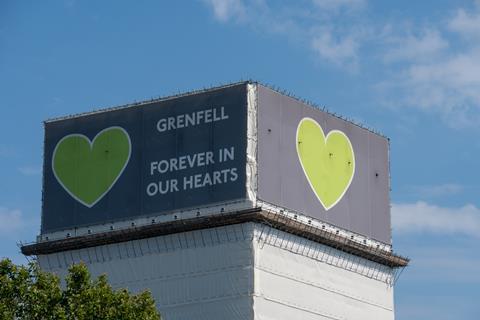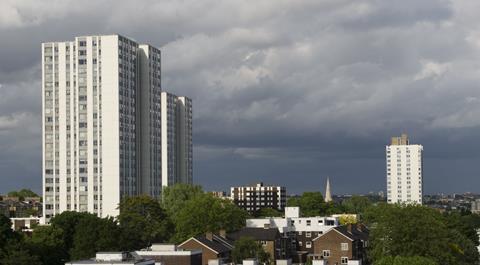The disastrous fire event at Grenfell Tower in 2017 marked the beginning of the latest batch of fire safety reforms. Antony Davis and Magdalena Prus examine what the outcome of the recent high-court decision in Martlet v Mulalley entails for designers and specifiers

The Grenfell Tower tragedy shone an unfavourable spotlight on significant parts of the UK construction industry. As a result, some common industry practices were subjected to intense – and overdue – scrutiny.
Central to this scrutiny was the investigation led by Dame Judith Hackitt resulting in the publication in May 2018 of Building a Safer Future, ‘The Independent Review of Building Regulations and Fire Safety.’ Attention on the topic has remained intense since then, partly due to the Grenfell Tower Inquiry and subsequent publication of its findings.
The Hackitt Report identified “the key issues underpinning the system failure” that led to Grenfell. Perhaps most notable of the issues identified included the ambiguity and misinterpretation of regulations and guidance, and the lack of clarity on roles and responsibilities within the construction industry.
These issues have become drivers for cultural change within the construction industry. This shift has been reinforced by a new and more stringent regulatory framework, including the Fire Safety Act 2021 and the Building Safety Act 2022, which also laid out clearer accountability within the design and construction process.
In parallel to the regulatory and legislative developments, related industry publications guided owners of existing high-rise residential buildings to begin a review of cladding systems on their properties.
The Department for Levelling Up, Housing & Communities estimates there are 12,500 high-rise residential buildings of 18 meters or more in height, or at least seven storeys, that fall within the category of ‘higher-risk buildings’ under the Building Safety Act 2022 in England. All of these have the potential to be subject to remediation to comply with the Act.
The uncertainty over the outcome of fire-related matters in litigation was also a point of discussion within the UK construction industry, particularly in light of a number of ongoing cladding-related disputes. Recently, and specifically addressing fire safety issues in the external wall construction of a high-rise building, the Technology and Construction Court closed the proceedings in the case of Martlet Homes Limited v Mulalley and Co Limited (Martlet v Mulalley) and issued the first High Court judgment since the Grenfell Tower disaster on this topic.
Design considerations of a ‘reasonable’ architect on fire-safety to be explored…
- A designer must account for all relevant and available guidance existing at the time of the design and construction of a project.
- The role of a specifier/designer to recognise a fire risk in using ‘combustible’ insulation – particularly in tall residential buildings – is clear.
- It would be wrong to afford a weight to the BBA Certificates above and beyond that which appears from the Building Regulations and approved documents themselves.
The case of Martlet v Mulalley
The Martlet v Mulalley case sets an important new precedent in terms of establishing that a designer must account for all relevant and available guidance existing at the time of the design and construction of a project.
To provide social housing, in the early 1960s five concrete tower blocks were built in Gosport, Hampshire. All five towers are significantly higher than 18 meters in height. This makes them special in terms of fire safety provisions and the level of risk to those occupying them.
In the early 2000s, Kelsey Housing Association Ltd. (a social housing company) decided to improve the towers’ resistance to cold and damp penetration by the application of an External Wall Insulation (EWI) cladding system to the exterior of the buildings (the original works).
The work was undertaken by Mulalley & Co Ltd under a design and build contract. The EWI cladding system consisted of expanded polystyrene (EPS) insulation boards, two coats of acrylic organic non-cementitious render finish, and horizontal mineral wool fire barriers.
Martlet Homes Limited is part of the Hyde Housing Group, one of the largest housing associations in England. Martlet acquired the Gosport towers in 2017. Nine days after the Grenfell Tower tragedy in June 2017, Martlet began investigating the EWI cladding system that had been designed and installed by Mulalley. Those investigations revealed that the system had numerous installation defects, and the EPS boards were ‘combustible.’
Martlet immediately implemented 24-hour waking watch patrols to ensure the safety of the residents. Martlet later replaced the EPS-based cladding system with a non-combustible alternative that used stone wool insulation panels (referred to in the case as the ‘replacement works’). Thereafter, Martlet halted the waking watch.
After an unsuccessful non-binding adjudication, Martlet issued court proceedings against Mulalley for the £8 million costs of the replacement works and the waking watch for four towers. At that point, Martlet claimed that the Mulalley installation workmanship breaches created the need for the replacement works and the waking watch.
Mulalley admitted to some installation defects but disputed the extent of the problems and argued a less expensive ‘repair’ rather than ‘replacement’ approach would have sufficed to remedy the installation workmanship breaches. Additionally, Mulalley argued Martlet’s realisation had been triggered by the Grenfell Tower disaster and the risks posed by combustible insulation not meeting heightened safety standards.
Furthermore, such heightened standards were not in existence until after the original works had been completed and accordingly, could not be applied retrospectively. The court held that Martlet had successfully proven the installation breach against Mulalley.
In response to Mulalley’s argument, Martlet also was successful in obtaining an alternative plea based upon an allegation that Mulalley’s design work resulted in a design breach as opposed to the installation workmanship breaches. Specifically, Martlet argued Mulalley’s failure to specify a compliant EWI system that met the applicable fire standards at the date of the original works contract was the root cause justifying the need for the replacement works and waking watch.

Statutory guidance and legislation
In the decision issued by HHJ Stephen Davies, he referred to a number of documents and guidance that were applicable to the design and construction of the towers at the time of the contract for the original works and at the time of the contract for the replacement works.
These included the Building Act 1984, the Building Regulations 2000 and 2010, the 2002 and 2006 editions of Approved Document B (ADB), and the 1988 and 2003 versions of the document entitled ‘Fire performance of external thermal insulation for walls of multistorey buildings’ (BR 135).
Regarding the “true interpretation of the relevant provisions”, the judge stated: “the proper interpretation… is to be found primarily from the words used”, and that “the provisions are intended to be read and relied upon by a wide range of persons”. He then provided several key points regarding the legislative framework, referencing the drafting of the applicable sections of the Building Act, the requirements of the Building Regulations, and provisions of ADB.
The judge confirmed that the objective of Requirement B4(1) of the Building Regulations for the external walls of buildings like the towers was for the design and installation to “adequately resist the spread of fire over the walls and from one building to another.” The decision went further to explain that such design and installation efforts must be achieved by considering the context and circumstances of a given project.
Furthermore, while the ADB guidance is not mandatory, if it cannot be demonstrated that the ‘functional’ requirement has been met by a properly considered alternative solution, a failure to follow the provisions set out in ADB would, as a default position, mean that a building (or part of it) does not comply with the Building Regulations.
Regarding the provisions of ADB, the relevant party should understand the requirements relating to the ‘spread of flame’ over the surfaces of external walls and ‘combustibility’ of materials forming the external wall construction.
The judge confirmed that the objective of Requirement B4(1) of the Building Regulations for the external walls of buildings like the towers was for the design and installation to “adequately resist the spread of fire over the walls and from one building to another.”
Furthermore, it was proposed in the judgment that the requirement for ‘drained and ventilated’ cavities in external wall cladding systems in the 2002 edition of ADB “reflected the understanding at the time that the presence of a ventilated cavity led to a risk of fire spread through that cavity.”
The judge also recognised substantive differences between the 2002 and 2006 editions of ADB, including those related to the use of materials ‘of limited combustibility’ in a building over 18 meters in height.
Specifically, the following differences were discussed in the decision:
As set out in three separate un-numbered sub-paragraphs under paragraph 13.7 of the 2002 ADB in a specific arrangement/situation:
- In buildings over 18 meters in height, “a fire risk in using combustible EPS insulation boards” is “clear”.
- A prohibition to use insulation of “anything less than limited combustibility” applied to systems with ventilated cavities only.
- While no express requirement in relation to “insulation panels as an over-cladding… [on the] reading [of] paragraph 13.7 as a whole… it could not be assumed that there was no restriction at all as regards their use,” further advice was specifically provided in the 2002 ADB by reference to BR 135.
An overarching approach was provided in the 2006 ADB:
- “… the second sub-paragraph is materially new” and provides that external walls should follow the ‘strict’ guidance in paragraph 12.6 to 12.9 of the 2006 ADB or meet the performance criteria in BR 135.
- Paragraph 12.7 of the 2006 ADB is “entirely new” and required “any insulation product” in the external wall construction of a building with a storey 18 meters or more above ground level, to be ‘of limited combustibility.
The differences between the 2002 and 2006 editions of the ADB may be significant in disputes depending on how the relevant parties interpret the ADB at the time of the design and construction of the project.
While the court recognised that although available guidance was limited to some extent, it indicated that the role of a specifier/designer to recognise a fire risk in using ‘combustible’ insulation – particularly in tall residential buildings – is clear. The court added that specifiers/designers should refer to BR 135 for further advice.
Regarding BR 135, the court made the following general comments:
- In the 1988 edition of BR 135, “the requirement for a full-scale fire test was only applicable in the limited cases specified.”
- The purpose of the 2003 edition of BR 135 was “to provide a fire performance assessment method from full scale fire test data [and] to offer design principles reflecting current products and systems.”
- While the 2003 edition of BR 135 did not specify the circumstances that the performance standard introduced therein was mandatory (in the end leaving this decision for specifiers/designers and regulators), this performance standard “could be adopted” in tall buildings with sleeping accommodations.

BBA certification is not a guarantee
The court concluded that Mulalley was responsible for the design as well as the execution of the original works, including the completion of the detailed design and the specification for the scheme.
One of the key areas of the dispute was the basis for the selection of the ‘StoTherm Classic’ system, which is a type of high-performance external wall system with continuous insulation and render finish, and the reference to the British Board of Agrément (BBA) Certificate for this product (number 95/3132). BBA is the UK accreditation body that provides certification for product conformity.
In his specific analysis of the evidence the parties provided, the judge focused upon the defendant’s architectural expert. The expert opined that at the date of the contract a typical designer/specifier would regularly specify ‘StoTherm Classic’ system for high-rise residential buildings.
The judge said: …it was a fair criticism of Mr [Euan] Geddes’ [architectural expert for the defendant] evidence that at times he appeared almost to suggest that it was sufficient for an architect pre-Grenfell to do little more than accept a BBA certificate at face value without need for much, if any, further investigation.
The judge was very clear on his view of BBA certification in relation to compliance with the Building Regulations: The BBA Certificates cannot be said to amount to a form of “guarantee” or “passport” to compliance with Building Regulations… it would be wrong to afford a weight to the BBA Certificates above and beyond that which appears from the Building Regulations and approved documents themselves.
The BBA Certificates cannot be said to amount to a form of “guarantee” or “passport” to compliance with Building Regulations.
Technical experts
In cases of this type, technical experts from different fields are typically appointed by the parties to provide their analyses and expert opinions on the actions of a party involved in the design and construction of a project. These experts also opine whether a party exercised the level of skill and care expected of another reasonably competent member of their respective professions.
The Judge gave his view in the written decision on how the expert witnesses should assist in such cases:
(a) to explain technical terms, which are not obvious or adequately explained in the material itself; or
(b) to explain how the provisions were understood by those involved in the design and specification of external cladding systems when considering the “professional negligence” aspect of this case.
The parties’ architectural experts agreed the original works did not comply with the applicable fire safety standards and guidance. Although ADB 2002 did not contain a specific requirement for the insulated over-cladding to be either “non-combustible or of limited combustibility”, a reasonably competent architect would have referred to BR 135 (1988) in the circumstances of this case. The fire-engineering experts essentially reached the same conclusion.
Key considerations
The following are key points from the court’s decision of specific interest to construction professionals that design and specify materials and systems for external walls in tall buildings:
- The court found that a specifier/designer should clearly acknowledge a fire risk when prescribing the use of ‘combustible’ insulation in tall residential buildings and refer to BR 135 for further advice, particularly in the circumstances not covered by ADB.
- While a ‘reasonable skill and care’ standard is a defence that designers often rely upon, following Martlet v Mulalley, a designer must account for all relevant and available guidance existing at the time of the design and construction of a project.
- Singular reliance or acceptance of a BBA Certificate (usually for an industry standard product) to justify variance from the guidance provided by the Requirements of Building Regulations and Approved Documents must be demonstrable by a clear, logical, and rational approach.
Ideally, these points would be in a designer’s scope of considerations going forward when designing and constructing projects.
Postscript
Postscript
Antony Davis is a forensic architect and expert witness at J.S. Held / Sense Studio. Magdalena Prus is an architect expert witness at J.S. Held / Sense Studio
















No comments yet